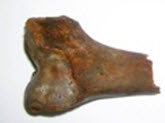Estimation of stature and sex from osseous fragments of long bones (femur, tibia)
Steel's method (1970) allows for the prediction of the individual stature considering the size of long bones osseous fragments (femur, humerus). However, the landmarks delimiting some fragments are not very accurate, which makes the method not very reliable.
A collection of femurs and tibiae from a sample of subjects of known age, sex and stature (from the ULB Body Donation program) is set up in the laboratory. The objectives of this study are in several stages: 1) Study of dimorphic characters of long bones osseous parts (diameters of the femoral head, diaphysis perimeters …); 2) Rebuilding of the entire long bones from a fragment and comparison with the data base; 3) Estimation of the stature from the rebuilt osseous fragment The sex and the stature of an individual are significant parameters with regards to the identification process.
Researchers : J.P. Beauthier; Ph. Lefèvre; V. Sholukha; S. Van Sint Jan; O. Snoeck; G. Quatrehomme (Laboratory of Forensic medicine and medico-legal anthropology - University of Nice).
Current research: - more than 50 anthropometric measurements have been performed on a specimen collection of 50 tibial and femoral bones. These specimens were also 3D reconstructed from medical imaging.
| This image shows one fragment of a femoral bone from a crime victim. Investigators are challenged by the fact the size and gender of the victim must be determined to allow identification. This study is aiming to offer new methods to improve field results. |  |
Need more information? Please contact ![]() !
!
 Laboratory of Anatomy, Biomechanics and Organogenesis
Laboratory of Anatomy, Biomechanics and Organogenesis